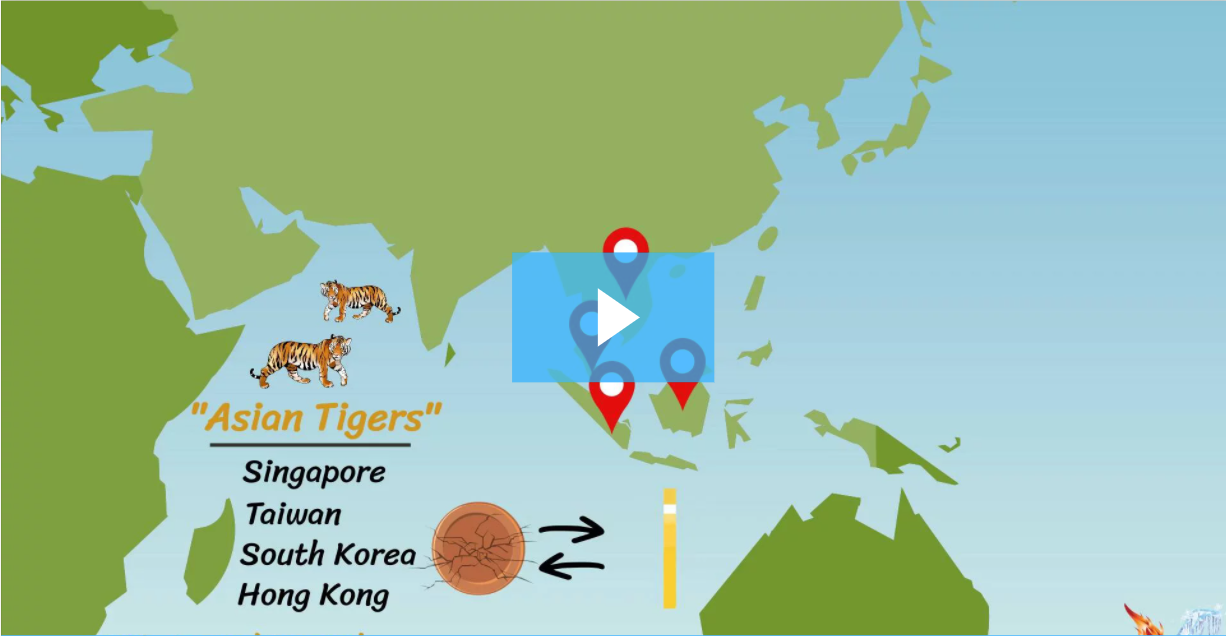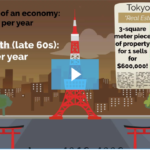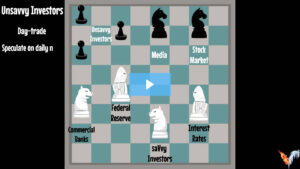
Japan’s economy was not the only economy to have been inflated by greed and busted by fear during the mid-20th century. Neighboring countries including Indonesia, Malaysia, Singapore, Taiwan, South Korea, and Hong Kong followed the same recipe of an economic boom, stagnation, and a subsequent bust. Although small in size, four countries in particular were known as the “Asian Tigers” including Singapore, Taiwan, South Korea, and Hong Kong. Hong Kong and Singapore established themselves as financial centers. All four Tigers also established themselves as manufacturing powerhouses including South Korean giant Samsung Electronics. The Asian Tigers focused on exports, low taxes, and government involvement as key driving forces to boost their nascent economies. Making education a priority and a high savings rate would further add to the success of the Asian Tigers. During the early part of the 1990s, exports for the Asian Tigers grew tremendously; Malaysia at 18%, 16% for Thailand, 14% for Hong Kong, and 15% for Singapore. A trade surplus occurs when a country exports more than it imports. A trade surplus is a positive for a country’s wealth. An export is an item a country produces and sells to a trading partner. A trade deficit occurs when a country imports more than it exports. A trade deficit is typically a negative for a country’s wealth. An import is a good a country purchases from a trading partner. The US runs a trade deficit regularly and is in deeply in debt for doing so. Despite running up an extremely high debt amount, the US maintains a high creditworthiness. This allows the US dollar to serve as the world’s reserve currency. Many of the larger banks in Europe and Japan were anxious to loan tens of billions of dollars to the local Asian Tiger banks. The Asian Tiger banks would then loan to local businesses. However, European banks did not feel comfortable loaning to the Asian Tiger countries whom of which had unstable currencies.
European banks would only lend to the Asian Tigers banks if a currency peg were established. A currency peg would allow for a more stable currency such as the US dollar to be “attached” to the local currencies such as the ringgit, won, and peso. The peg would provide the local currencies stability as the US dollar would hold its value better. Once the currency peg was established, European banks began lending to the Asian Tiger banks. The Asian Tiger economies would be able to further their economic growth because of increased lending from European banks. To illustrate how increased lending from European banks benefitted the Asian Tiger economies, the following example is provided. Suppose for every $1 million in US dollar reserves, an Asian Tiger bank can loan up to 5 million ringgits to local businesses. Now that the ringgit is pegged to the US dollar, European and Japanese banks are more willing to lend to Asian Tiger banks. An Asian Tiger bank can now increase their dollar reserves by borrowing US dollars from European banks. Now suppose that same Asian Tiger bank has now increased their US dollar reserves from $1 million to $10 million. This has increased the number of ringgits the Asian Tiger bank can loan from 5 million to 50 million.
Once the Asian Tiger bank borrows US dollars from a European bank and loans out ringgits, the following currency position would appear on both of the bank’s financial statements. The Asian Tiger and European banks went “short” or borrowed dollars and went “long” or bought ringgits. The Asian Tiger bank will pay a lower interest rate to European banks to borrow US dollars since the dollar is more stable. Since the prospects of the local business are unknown and risky, the Asian Tiger will earn a higher interest rate on the ringgits they loan out to local businesses. The Asian Tiger bank would profit on the difference in interest paid to the European bank and interest earned from the local business. As the amount of lending increased, the size of the short US dollar, long Asian Tiger currency trade also increased.
The Asian Tiger economies began running a trade deficit as a result of misallocated capital. Malaysia began to run a trade deficit of 8.8% of the country’s gross domestic product (GDP) by 1995. In 1993, Thailand began running a deficit of 5.7%, increasing to 6.4% in 1994, then 8.4% in 1995, and 8.5% in 1996. Much like the US housing market boom in early 2000, Asia experienced a real estate boom in the early 1990s. The amount of investment in the local economies was disproportionately placed into real estate developments with overly ambitious prospects such as the world’s most expensive steel mill and the world’s largest dam. As property values were increasing 25% per year during the early 1990s around much of Asia due to tax incentives, banks naturally poured funds into real estate. This overinvestment led to an oversupply of real estate. By early 1997, 365,000 newly-built apartments were sitting in Bangkok unoccupied. Currency traders noticed the pain the Thai economy was experiencing. Thailand’s currency, the baht, was pegged to the US dollar and would soon face a strain as the baht’s pegged value was not reflective of its true underlying value. Currency traders anticipated the peg would be removed so they began buying US dollars and shorting the Thai baht. On February 5, 1997 a prominent Thai real estate developer, Somprasong Land, announced it would default on its bond payments as it could not make its $3.1 million interest payment on an $80 billion loan. Already down 45% from its peak, the Thai stock market continued to decline 2.7% after the announcement. Finance One, the key Thai bank in between property developers and international banks, announced bankruptcy in 1997 as the banks number of defaulted loans doubled in 1996 and again in the first quarter of 1997. As the economic news worsened, currency began taking larger bets in the long US dollar, short Thai baht trade. Attempts were made by the Thai government to help support the baht’s value. The Thai government began using its own dollar reserves to buy the baht, deploying $5 billion of the country’s reserves to battle the short sellers. The Thai government also raised interest rates 25% in hopes of bringing back return-hungry investors. However, raising interest rates only made the economic problems worse as interest payments ballooned. As the government’s dollar reserves began dwindling, the truth about how many dollar reserves the Thai government had remaining was revealed. It was reported the Thai government had $33 billion left in dollar reserves. However, on July 2, 1997 the Thai government announced it only had $1 billion in reserves left since it had deployed $32 billion in futures contracts to try and stabilize the baht. As a result, Thailand was forced to de-peg their currency and let it float freely. Short sellers were immediately rewarded as the baht dropped 18% instantly upon the announcement.
The Thai baht was not the only currency bubble to have popped. The Indonesian rupiah, Malaysian ringgit, and the Singaporean dollar saw its values decline substantially. Drops in the Asian currencies included the Indonesian rupiah’s exchange rate going from 2,400 rupiah to $1 to 10,000 rupiah to $1 in just the span of four months between August 1997 and January 1998. As a result, the debt owed to European banks quadrupled. Years of overbuilding, corruption, and crony capitalism was now catching up to the Asian Tiger economies. Malaysia’s Prime Minister resorted to conspiracy theories as way of explaining the reason for a crash in the currency. Famed short-seller George Soros was blamed for tanking the country’s currency. Japanese banks that lent to the Asian Tigers also started to feel the pain. The seventh-largest brokerage in Japan, Sanyo Securities announced bankruptcy on November 3, 1997. A week later, the tenth-largest bank, Hokkaido Takushoku announced bankruptcy. Less than two weeks later, Japanese securities firm Yamaichi also filed for bankruptcy. At the end of 1997 and into the beginning of 1998, some Asian markets had lost 75% of its value. Real estate slowed down as well. Jakarta and Bangkok had a 10% and 15% vacancy rate, respectively. The International Monetary Fund (IMF) could only apply the band aid of cheap loans to the Asian Tigers until after the damage had been done. $110 billion dollars in loans were deployed by the IMF to Indonesia, Thailand, and South Korea. Eventually, these economies and currencies recovered. By the start of 1998, the IMF had provided loans to 75 different countries in the world and set out plans for government reform, alterations in economic operating procedures, taxes, and interest rates. However, volatility would again rear its two-sided head as the natural emotions of greed and fear would fuel the Russian stock market bubble of the 1990s.







